by Winding Pathways | Sep 7, 2017 | Preparedness
Images in the nightly news from Houston during and after Hurricane Harvey are heartbreaking. It will take years for flooded communities and families to recover.
Harvey reminds us that disasters can happen anywhere at any time. Some are relatively predictable. For example, tornadoes and hurricanes are most likely to hit certain places during parts of the year.
Other disasters are impossible to predict. We remember that years ago a worker accidentally set a fire that burned an enormous quantity of Styrofoam insulation in the roof of a sewer building near our home. Clouds of toxic smoke billowed out, and the mayor ordered an immediate evacuation.
Fortunately, we were prepared. Within fifteen minutes we loaded our survival bin, sleeping bags, a tent, drinking water and our two young kids in the car. An hour later we were camped well away from the smoke.The next day the fire was out, the air clean, and we were home.
Everyone should make emergency plans and acquire emergency items in case of a disaster that shuts down local stores and utilities or forces an evacuation.
Click on the Preparedness Section of windingpathways.com for specific tips on how to survive disasters and a list of suggested items to stock in a disaster kit.
by Winding Pathways | May 2, 2017 | (Sub)Urban Homesteading, Preparedness
At Winding Pathways we wrote periodically about preparedness. Usually, it’s related to the potential for seasonal weather-related events. Almost every day someone somewhere suffers damage from a tornado, hurricane, ice storm, blizzard or some other natural disaster. Sometimes we simply discover an alternative use for emergency equipment. Sterno is one! It’s as simple as a quick way to heat water for tea or coffee while working in the cabin or out camping.
We all realize that when the power goes off it’s helpful to have back up lighting and cooking equipment on hand. Propane and liquid gas stoves designed for camping are ideal for emergencies when the power goes off, but they are pricey. A lower cost alternative is a “Sterno” stove or equivalent. These are inexpensive lightweight stoves that fold flat and take almost no storage space. They are sold in big box stores that stock camping equipment.
The common fuel for these stoves is “Sterno”, a gel made from alcohol and contained in a small aluminum cup. You pry off the lid, stick the fuel cup in the stove, light it, and it’s ready for cooking. Sterno stoves cook slowly. They’re not the best for elaborate cooking but are perfectly suited for a few days of light meal preparation until the power comes back on.
We’ve found that fuel cans sold in restaurant supply stores and called “Chafing Fuel” are less expensive than buying fuel in a camping store. These are mostly used by caterers for keeping food warm at buffets, and they work great for emergency cooking, too! For information go to Sterno Products.
Please note that Winding Pathways has no connection with the Sterno Company. We like their products but have not received money or materials from them.
-
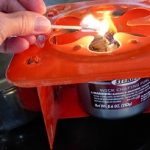
-
Lighting Sterno
-
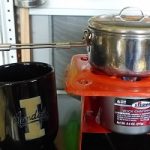
-
Sterno is a handy way to heat water.
-
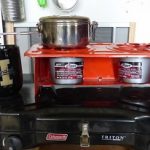
-
Two burner Sterno
by Winding Pathways | Mar 29, 2017 | Chickens, Preparedness
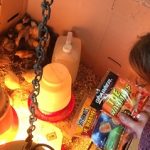
Keep hand warmers nearby in case of power outage.
We weren’t worried when a 37-degree north wind took to blowing on Saturday, March 25th. Our chicks were safe inside the barn brooder. Then, our electric power went out. Normally that wouldn’t be a problem. Our wood stove keeps the house warm without electricity and we have camp stove for cooking. And the adult chickens do well in most weather.
However, the sudden unexpected loss of electricity threatened our 50 baby chicks living in a plywood brooder under heat lamps out in the barn. Electric heat lamps normally keep them snugly warm in the otherwise cold barn.
We heard about the power failure while shopping. It took a half hour to get home and we found the cold chicks huddled together in a vain attempt to keep warm. We had no idea how long the power would be off so immediately put our back up plan in place. Here’s what we did:
- Filled two plastic jugs with hot water and placed them near the chicks. The babies immediately snuggled up to the warm bottles.
- Tore the plastic covering off six chemical hand warmers to activate them. These are sold to farmers, carpenters, and hunters to keep their pockets warm during winter outings. They get very warm but not hot. We put them under the chicks.
The milk jugs and hand warmers didn’t warm the entire brooder, but they did keep the chicks warm enough to survive three hours until the power came back on.

Chicks huddle together when cold.
Anyone brooding baby chicks should have a back-up plan to keep their peeping friends warm in case the electricity goes out. A couple of milk jugs and a few hand warmers can prevent a disaster.
by Winding Pathways | Mar 6, 2017 | (Sub)Urban Homesteading, Preparedness

Thunderstorms carry the risk of wind, lightning and power outages.
The United States seems to have one storm season followed by another. The year starts with blizzard threats and then transitions into tornado season. That’s followed by hurricane season until blizzards again become possible in late fall.
Many people have prepared for loss of utilities caused by a huge storm. They have food, water, and emergency lights ready, but Hurricane Sandy revealed that many had forgotten one important modern survival need.
When Sandy shut down electrical service to millions of Americans cell phone companies turned on their back-up generators and the system continued to work. But, most cell phone owners had no way to recharge their phones and other electronic devices. Being unable to use their phone caused anxiety. After a few days many towns set up charging stations in public buildings powered by big generators, but to use one involved a drive and wait.
An outstanding item to add to an emergency pack is a back-up battery and emergency cell phone charger. Many solar powered chargers are on the market. Often they are marketed to backpackers and wilderness trekkers, but they work just as well in the city. Simply plug the charger into the phone and put it in sunshine and it will recharge the phone’s battery.
Another solution is to keep handy a back-up battery that will charge a phone. Many are on the market, and even cordless tool batteries often have a port that enables power to flow from the tool’s battery to the phone. A spare battery will often recharge a phone a couple of times. Solar chargers are limitless but the sun needs to shine.
- Winding Pathways does independent, unpaid reviews of products.
FOR DETAILS ON HOW TO STOCK A PREPAREDNESS KIT SEE THE WINDING PATHWAYS BLOG.
by Winding Pathways | Dec 20, 2016 | (Sub)Urban Homesteading, Preparedness
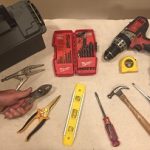
We keep an array of hand tools for small projects around the home and yard.
Our home at Winding Pathways shares needs familiar to every homeowner or renter. Things break, new items need to be assembled and pictures need to be hung. A basic set of household tools makes common tasks easy, even for people not particularly handy.
We have dozens of tools. Many are specialized, and only occasionally used but our list of frequently used tools are ones that will prove useful in every home. *Here are our favorites:
Pliers. Three types. One is a simple pair of gripping pliers used whenever something needs to be held tightly. A second is needle nosed (or long nosed) pliers used to grab and hold small items. They make fishing small items that fall into crevices easy. The third is a pair of locking pliers, often called “Vice Grips”. They make it easy to tightly grip something using only one hand, leaving the other free to do work.
Screwdrivers: A quality, old fashioned slotted screwdriver is invaluable around the house. We use ours for all sorts of things that have nothing to do with driving a screw. Prying and scraping are only two of dozens of uses. A few years ago we bought a much more useful screwdriver for inserting and removing screws. It’s actually a multi screwdriver all-in-one tool. If you have ever climbed up a ladder to remove a screw only to discover that the screw’s head is different from the screwdriver in hand, you will find this tool the best! Our new one has six different bits, all designed to fit different types of screw. Various bits are stored in the handle, making it almost certain the tool will work no matter what type screw is encountered.
Cordless Electric drill: The only power tool on our list is an amazingly versatile tool. Drilling holes is only one of many tasks it completes with ease. In addition to a case of drill bits of various diameters other bits are actually screwdriver tips or sockets. They make fast work installing or removing screws, nuts, and bolts. Many other attachments fit on a drill, including buffing and sanding wheels. We can’t imagine not having this tool. Corded drills need to be plugged in, making them much less convenient. Cordless models come with rechargeable batteries that provide much power before needing to be put back on the charger.
Ear Muffs: Loud noises lead to gradual hearing loss. We wear muffs whenever we are around loud machine noises – blenders, vacuum cleaner, lawn mower, power tools, and this time of year snow blowers!
Utility Knife: Useful for cutting cardboard boxes and most anything else. Most hold spare sharp blades in the handle.
Adjustable Wrench: These come in many sizes but we’ve found the eight inch models best for common household uses. The tool adjusts to fit nuts of various sizes.
Level: A small compact torpedo type level is amazingly useful for hanging pictures, or leveling a table or desk.
Hammer: Hammers aren’t really obsolete. We use ours to drive nails but also to tap the screwdriver when prying or scraping and for many other tasks around the house. Years ago, Marion’s mom standing at a towering 4’9” willed her tiny hammer to us that works amazing well for light projects.
Scissors: These aren’t office scissors but heavy duty shears that easily cut through heavy packaging materials, thin metal, and cardboard.
Black Tape: Sometimes called electricians tape, this isn’t strictly a tool but it’s amazingly useful in holding things together or temporarily patching a dripping pipe or exposed wire.
HOW TO ACQUIRE TOOLS
Quality hand tools are a joy to use and so durable they can last for generations. We are using wrenches, screwdrivers, and a hammer that are as functional today as they were to our grandfathers purchased them 80-some years ago. New quality hand tools can be purchased today – but beware! Many poorly made models are on the market and sold mostly in discount and big box stores. They are less expensive than good ones but aren’t as reliable and probably won’t be around to pass on to the next generation.
We buy our tools in two places – garage and estate sales that often include vintage hand tools. They may be a bit rusty, but we’ve bought quality tools for pennies. After refurbishing they are as good as new. When in the market for new tools we head for a specialty tool store. These are where professional carpenters, plumbers, electricians, and other craft people buy their tools and equipment.
Our favorite store in Cedar Rapids is Acme Tools. They only sell quality tools made by many manufacturers and we’ve never been unhappy with any tool purchased there. In recent years we’ve been purchasing Milwaukee brand tools at Acme and have found them top notch. “We only sell high quality tools, and our sales people are experts always happy to help customers select the right tool for their needs and show them how to safely use it,” said John Guidinger, General Manager.
Quality tools are more than just tools. They are well designed and crafted instruments that feel good in your hands and help making tasks a pleasant experience.
*Blogger Note: These are independent, unpaid reviews.
by Winding Pathways | Sep 30, 2016 | Preparedness
With an enormous flood surge coming down the Cedar River many homeowners were told to evacuate. Twice in eight years we’ve helped families facing evacuation only to find them mentally frozen and unable to decide what to take and what to leave.
Evacuations are difficult. No one ever wants to be forced from their home, but everyone should realize the possibility that it can happen due to a wildfire, hurricane, flood, tornado, or some other disaster.
But back to our friends who needed to decide quickly what to take with them. Neither had made any prior plans and both seemed to want to save large items, like furniture. They were mentally confused and seemed unable to decide what they should quickly grab and easily fit into their car.
That’s when we stepped in. “Take the things that can’t easily be replaced and will be useful in the next few days,” we advised. These include:
- Critical papers: like insurance documents (life, home, health), financial items, check books, credit cards, birth certificates, mortgage papers
- Many people have the most important information on their smart phone.Documents and contact information on an external hard drive. Grab them quickly and they’ll be an invaluable help during evacuation. Remember the chargers!
- Cash in small bills.
- Personal items needed for a few days and nights. Medicines. If time allows bring some clothing, flashlight, jackets, and toiletries.
- Contact information. Phone numbers and addresses of family and friends, financial advisers, physicians, insurance agent, and anyone else you may need to contact.
- Family photos and small mementos.
- Pets if possible.
The Winding Pathways website includes several blogs that help homeowners prepare disaster bins in advance of a crisis that help them survive for short periods without utilities and what to grab in an emergency. Click on “Preparedness” to see the blogs.







